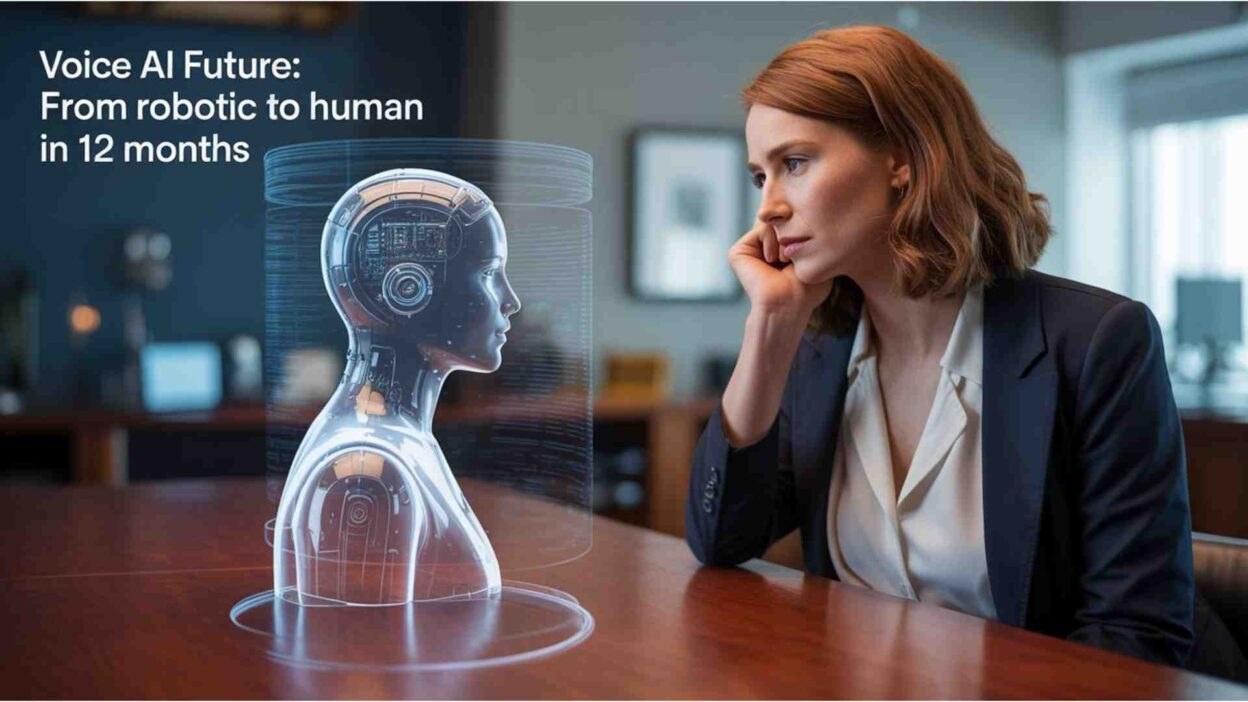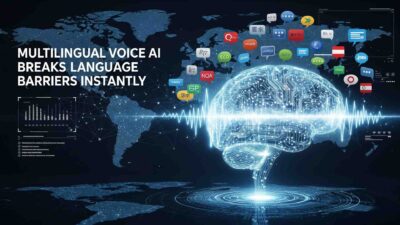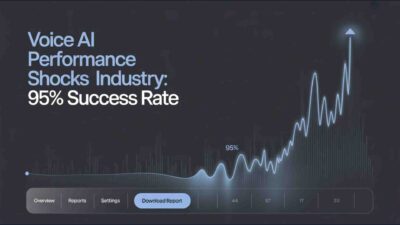TL;DR The voice AI future is transforming rapidly from robotic responses to human-like conversations. Advanced neural networks now create natural speech patterns. Voice assistants understand context better than ever before. Emotional intelligence integration makes AI voices feel authentic. The technology shift impacts customer service, healthcare, and education sectors. Users expect seamless human-robotic interactions by 2026.
Table of Contents
Introduction
The voice AI future represents a massive leap from mechanical responses to genuine human conversation. Voice technology has evolved beyond simple command recognition. Modern AI systems now process emotions, context, and nuanced speech patterns. This transformation affects how we interact with technology daily.
The Current State of Voice AI Technology
Understanding Natural Language Processing
Voice AI systems today use sophisticated algorithms to decode human speech. Machine learning models analyze tone, pitch, and emotional undertones. These systems recognize regional accents and speech variations. The technology processes thousands of voice samples to improve accuracy.
Real-Time Speech Recognition Capabilities
Modern voice AI platforms achieve 95% accuracy in speech recognition. Cloud-based processing enables instant response times. Voice systems now handle multiple languages simultaneously. Background noise filtering has improved dramatically over recent years.
Breaking Down the Robotic Barriers
Eliminating Mechanical Speech Patterns
Traditional voice AI sounded monotone and predictable. New neural voice synthesis creates dynamic speech patterns. AI voices now pause naturally during conversations. Inflection changes based on context and emotional cues.
Adding Emotional Intelligence to Voice Systems
The voice AI future includes emotional recognition capabilities. Systems detect frustration, excitement, and confusion in user voices. AI responses adapt based on the speaker’s emotional state. This creates more empathetic and effective interactions.
The Human-Like Voice Revolution
Neural Voice Synthesis Breakthroughs
Deep learning models generate incredibly realistic human voices. Voice cloning technology creates personalized AI assistants. The voice AI future allows customization of tone and personality. Users can select voices that match their preferences perfectly.
Conversational Context Awareness
AI systems now remember previous conversation topics. Voice assistants maintain context across multiple interactions. This eliminates the need to repeat information constantly. Natural conversation flows become possible with advanced memory systems.
Industry Applications Driving Change
Healthcare Voice AI Transformations
Medical voice AI assists doctors with patient documentation. Voice systems schedule appointments and answer basic health questions. The technology reduces administrative burden on healthcare staff. Patient interaction becomes more efficient through voice automation.
Customer Service Evolution
Voice AI handles complex customer inquiries without human intervention. The voice AI future reduces wait times significantly. Customers receive instant responses to common questions. AI systems escalate complex issues to human agents when necessary.
Educational Voice Technology
Voice AI tutors provide personalized learning experiences. Students practice languages with AI conversation partners. The technology adapts to individual learning speeds and styles. Voice-based education becomes more accessible and engaging.
Technical Innovations Shaping the Future
Advanced Machine Learning Models
Transformer architectures improve voice understanding capabilities. Self-attention mechanisms help AI focus on relevant speech segments. Continuous learning allows voice systems to improve over time. These models process speech more efficiently than previous generations.
Edge Computing Integration
Voice processing now happens locally on devices. This reduces latency and improves privacy protection. Edge computing enables offline voice AI functionality. Users experience faster response times without internet connectivity.
Challenges and Solutions
Privacy and Security Concerns
Voice data contains sensitive personal information. Companies implement end-to-end encryption for voice communications. Local processing reduces data transmission risks. Users gain more control over their voice data storage.
Accuracy Across Diverse Populations
Voice AI systems need training on diverse speech patterns. Accent recognition requires extensive multilingual datasets. The voice AI future must serve global populations equally. Bias reduction becomes crucial for fair AI deployment.
The 12-Month Transformation Timeline
Months 1-3: Foundation Building
Companies invest in neural voice synthesis infrastructure. Training datasets expand to include diverse voice samples. Early implementations focus on specific use cases. Beta testing begins with select user groups.
Months 4-6: Integration Phase
Voice AI systems integrate with existing platforms. Customer service departments adopt AI voice assistants. Healthcare providers test voice documentation systems. Educational institutions explore voice-based learning tools.
Months 7-9: Refinement Period
User feedback drives system improvements. AI models learn from real-world interactions. The voice AI future becomes more predictable and reliable. Performance metrics show significant accuracy gains.
Months 10-12: Full Deployment
Voice AI systems reach human-like conversation quality. Mass adoption occurs across multiple industries. Users prefer AI voices over traditional interfaces. The transformation from robotic to human voices completes.
Impact on User Experience
Seamless Human-AI Interaction
Voice conversations feel natural and effortless. Users forget they’re speaking with AI systems. The voice AI future eliminates friction in digital interactions. Technology becomes more accessible to all age groups.
Personalized Voice Assistants
AI voices adapt to individual user preferences. Conversation styles match user personalities. Voice assistants remember personal details and preferences. This creates deeper connections between users and technology.
Future Predictions and Trends
Voice AI in Smart Homes
Smart home devices will feature human-like voice personalities. Voice control becomes the primary interface for home automation. The voice AI future includes proactive assistance based on user habits. AI systems anticipate needs before users make requests.
Professional Voice AI Applications
Business meetings will include AI voice assistants. Voice AI will handle scheduling, note-taking, and follow-up tasks. Professional communication becomes more efficient through voice automation. The technology transforms workplace productivity significantly.
Global Voice AI Adoption
International markets embrace voice AI technology rapidly. Multilingual voice systems serve diverse populations. The voice AI future breaks down language barriers effectively. Cross-cultural communication improves through AI translation.
Read More: How to Use Voice-to-Voice AI For Free And Manage Voicemail
Conclusion

The voice AI future transforms from mechanical responses to authentic human conversation within twelve months. This evolution impacts every industry and changes how we interact with technology. Voice AI becomes an invisible, natural part of daily life. The robotic era ends as human-like AI voices become the new standard. Users will experience seamless, intelligent conversations that feel completely natural. The transformation represents one of the most significant technological shifts in recent history.






[…] Read More: Voice AI Future: From Robotic To Human In 12 Months […]
[…] Read More: Voice AI Future: From Robotic To Human In 12 Months […]
[…] Read More: Voice AI Future: From Robotic To Human In 12 Months […]
[…] Read More: Voice AI Future: From Robotic To Human In 12 Months […]